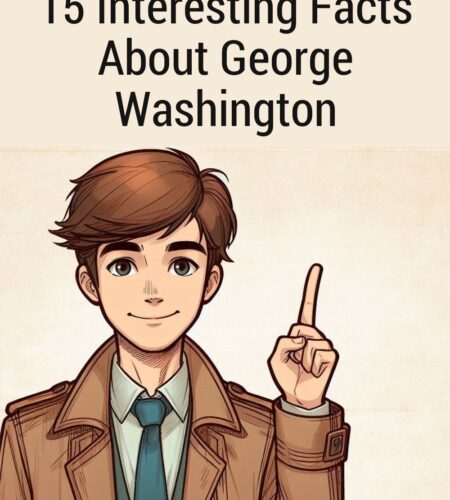George Washington, often referred to as the “Father of His Country,” was a pivotal figure in American history. As the first President of the United States and a revolutionary leader, he left an indelible mark on the nation’s foundation. In this article, we’ll explore 15 fascinating facts about George Washington that shed light on his life and legacy.
Introduction
George Washington was not only a statesman and military leader but also a symbol of American ideals. His leadership during the American Revolutionary War and his role in crafting the U.S. Constitution established his place in history. Let’s delve into the intriguing details of his life.
Fact 1: Mount Vernon, His Beloved Estate
A Grand Plantation: George Washington’s home, Mount Vernon, was a sprawling plantation located in Virginia. It spanned over 8,000 acres along the Potomac River and included a stately mansion, numerous outbuildings, and extensive farmland.
Resting Place: George and Martha Washington are both buried at Mount Vernon. Today, Mount Vernon is a popular historical site and museum, preserving the legacy of the first U.S. president.
Historical Preservation: Mount Vernon is considered one of the most well-preserved 18th-century estates in the United States.
Fact 2: His Early Military Experience
The French and Indian War: Before the American Revolution, George Washington gained valuable military experience during the French and Indian War. He was commissioned as a lieutenant colonel in the Virginia Regiment and led troops against the French.
Fort Necessity: Washington’s first command was at Fort Necessity, where he faced defeat but gained essential experience that would serve him well in the future.
A Foundation for Leadership: His military experience during this conflict contributed to his reputation as a capable leader and commander.
Fact 3: The First President of the United States
Inaugurated in New York City: George Washington was inaugurated as the first President of the United States on April 30, 1789, in New York City, which was then the country’s capital.
Unanimous Election: Washington’s election was unanimous, making him the only U.S. president to receive all the electoral votes.
The Presidency’s Precedents: As the first president, Washington established many precedents, including a two-term limit and the title “Mr. President.”
Fact 4: His Signature Hair
The Iconic Wig: George Washington’s distinctive hairstyle was not achieved through a wig but with his own hair, which he powdered and tied back. This style was influenced by the fashion of the 18th century.
Powdered Wigs in Society: Powdered wigs were popular in European courts and high society at the time, but Washington’s practicality led him to maintain his natural hair.
A Symbol of His Simplicity: His choice to forgo the powdered wig and wear his own hair was a reflection of his modesty and practicality.
Fact 5: The Cherry Tree Myth
The Tale of Honesty: The story of George Washington chopping down a cherry tree as a young boy and confessing to his father, “I cannot tell a lie,” is a famous anecdote that symbolizes his integrity.
Apocryphal Origins: While the cherry tree story is well-known, there is no concrete evidence to confirm its authenticity. It is likely a fictionalized account created to emphasize Washington’s honesty.
A Lesson in Virtue: Despite its historical accuracy, the cherry tree tale endures as a valuable lesson in integrity and personal virtue.
Fact 6: His Dental Troubles
Dental Issues: George Washington endured a lifetime of dental problems. By the time he became president, he had lost many of his teeth and suffered from severe toothaches.
Ivory Dentures: Contrary to popular belief, Washington did not have wooden dentures. His dentures were made from materials such as human teeth, animal teeth, and ivory.
Constant Discomfort: His dental issues caused him significant pain and discomfort throughout his life.
Fact 7: Washington’s Contributions to the Constitution
Constitutional Convention: George Washington was chosen as the president of the Constitutional Convention in Philadelphia in 1787, where the United States Constitution was drafted.
A Guiding Hand: While he didn’t actively participate in the debates, his presence lent credibility and authority to the proceedings.
Ratification Efforts: Washington played a pivotal role in promoting the ratification of the Constitution after its completion.
Fact 8: The Whiskey Rebellion
Suppressing the Rebellion: In 1794, George Washington led federal troops to suppress the Whiskey Rebellion, a violent protest against the whiskey tax imposed by the federal government.
Asserting Federal Authority: This action demonstrated the government’s willingness to use force to uphold federal law and maintain its authority.
Significance in American History: The Whiskey Rebellion underscored the importance of a strong federal government and its role in maintaining order and enforcing laws.
Fact 9: Farewell Address
A Guiding Document: George Washington’s Farewell Address, delivered in 1796, was a seminal political statement. In it, he advised the nation to remain neutral in foreign affairs and to avoid political factionalism.
A Legacy of Neutrality: His counsel to steer clear of “entangling alliances” has had a profound and lasting influence on U.S. foreign policy.
Continued Relevance: Washington’s Farewell Address is still cited in discussions on foreign policy and political unity.
Fact 10: An Unanimous Choice for President
Electoral Unanimity Twice: George Washington was unanimously elected as President not just once but twice, serving two consecutive terms from 1789 to 1797.
A Singular Achievement: No other U.S. president has achieved this level of electoral consensus.
Reluctant Acceptance: Washington initially had reservations about serving a second term but agreed to do so due to the nation’s need for his leadership.
Fact 11: The Potomac Canal Company
A Vision for Transportation: George Washington was an advocate for internal improvements and transportation infrastructure. He was the president of the Potomac Canal Company, which sought to make the Potomac River navigable.
Connection Between the East and West: His support for the canal was driven by his vision of connecting the Eastern Seaboard with the interior of the country.
Today’s C&O Canal: The Potomac Canal Company’s efforts laid the groundwork for the Chesapeake and Ohio Canal (C&O Canal), a significant transportation route during the 19th century.
Fact 12: The Crossing of the Delaware River
Iconic Image of Determination: George Washington’s crossing of the ice-filled Delaware River on Christmas night in 1776 is an enduring symbol of American determination and resolve.
Surprise Attack: The daring crossing led to a surprise attack on Hessian forces in Trenton, New Jersey, and marked a turning point in the American Revolutionary War.
A Grueling Night: The crossing was a perilous journey, with men and horses navigating ice floes and harsh winter conditions.
Fact 13: The President Without a Political Party
A Non-Partisan President: George Washington was the only U.S. president who served without being a member of a political party. He believed in the dangers of political factionalism.
Unity Over Division: Washington’s emphasis on unity and impartiality is reflected in his actions as president.
Legacy of Neutrality: His non-partisan stance set a precedent for presidents who aimed to remain above the fray of party politics.
Fact 14: His Relationship with Slavery
A Complex Legacy: George Washington’s stance on slavery was complex. He owned enslaved individuals, but he also expressed concerns about the institution.
Manumission of Enslaved Individuals: Upon his death, Washington’s will provided for the manumission (freedom) of the enslaved individuals he owned.
His Moral Struggles: His evolving views on slavery reflected the moral and ethical conflicts surrounding the issue in the 18th century.
Fact 15: The One-Dollar Bill
The Father of His Country on Currency: George Washington’s portrait is featured on the one-dollar bill, a symbol of his significance to the nation’s history and its economic stability.
Continued Honor: His image on U.S. currency is a lasting tribute to his leadership and his role in the creation of the new nation.
A Reminder of the Founding Era: Every time you use a one-dollar bill, you hold a piece of American history in your hand.
Conclusion
George Washington’s life was filled with accomplishments, challenges, and enduring contributions to the United States. From his role as a military leader in the Revolutionary War to his pivotal position as the first President of the United States, he remains a symbol of leadership, integrity, and the American spirit. These 15 facts offer a deeper understanding of the man behind the legend and the lasting impact he had on the nation.
Subscribe to our email newsletter to get the latest posts delivered right to your email.





Comments